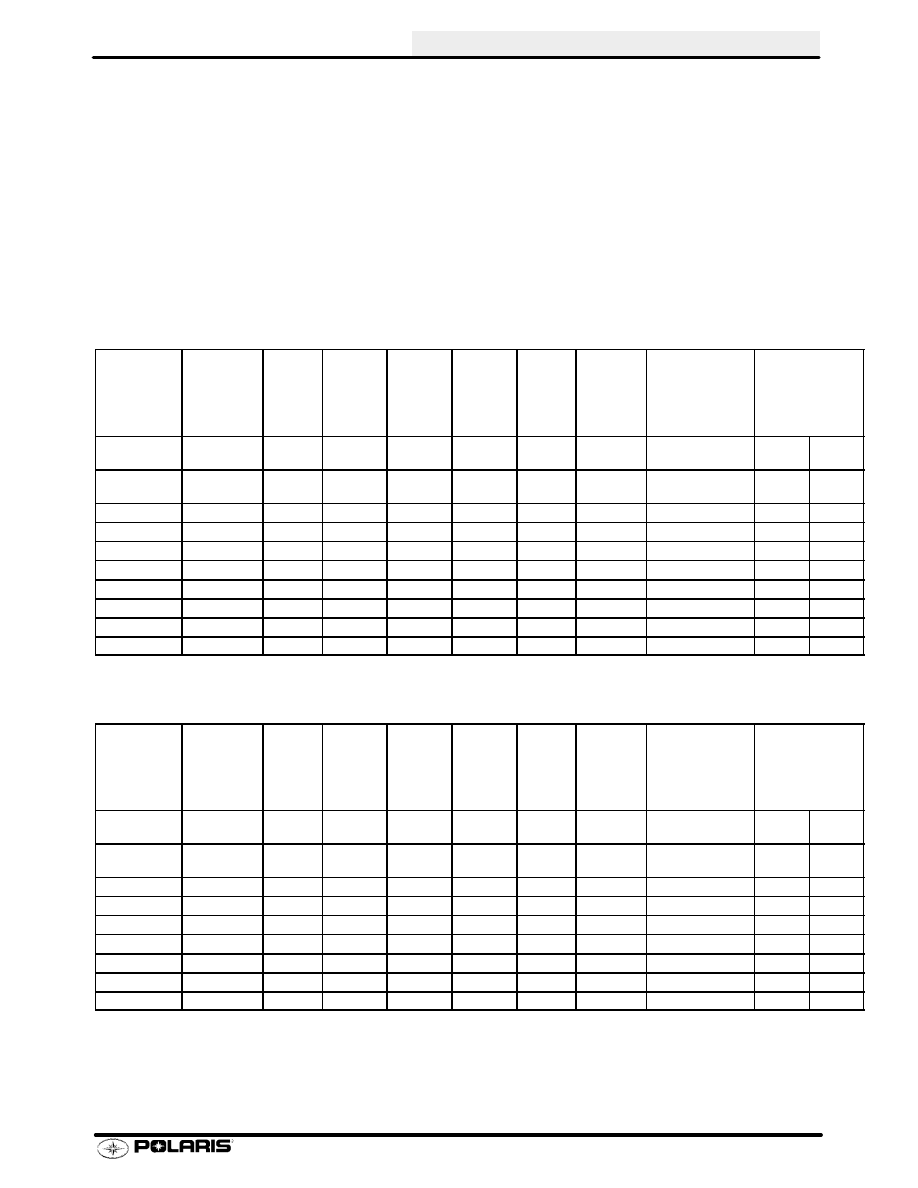Snowmobile Polaris High Performance (2001 year). Manual - part 73

REAR SUSPENSION/TRACK/TRACTION
7.3
2001 Suspension Torque Specifications
3/8
〉
suspension mounting bolts
35 - 40 ft. lbs. (48 - 55 Nm)
. . . . . . . . . . . . . . . . . . . . . . . . . . . . . . .
7/16
〉
suspension mounting bolts (EDGE PRO X)
55 - 60 ft. lbs. (76 - 83 Nm)
. . . . . . . . . . . . . . . .
Shock rod bolts (do not over torque) (X--10)
12 ft. lbs. (16.6 Nm)
. . . . . . . . . . . . . . . . . . . . .
Shock rod bolts (do not over torque) (EDGE PRO X)
25 ft. lbs. (34.6 Nm)
. . . . . . . . . . . . .
Xtra-10 and Edge Rear Track Shock Upper Pivot Torque
25 ft.lbs (34.6 Nm)
. . . . . . . . .
Shock rod bolts (do not over torque) EDGE
35 ft. lbs. (48.4 Nm)
. . . . . . . . . . . . . . . . . . . . .
* Shock rods must pivot freely after torquing
NOTE: 2000 Bogie wheel is 5.35” and 2001 Bogie wheel is 5.62”
2001 Rear Suspension Specifications
Model
Rear
Suspension
Front
Track
Shock
PN
Front
Track
Shock
(Type)
Front
Track
Shock
Spring
PN*
Front
Track
Shock
Spring
Rate
(lb./in.)
Rear
Track
Shock
PN
Rear
Track
Shock
Desc.
Torsion Spring
Part Number*
Left / Right
Torsion Spring
Diameter / Angle
(Rear Shock
Spring Rate)
XCF SP
Edge Pro X
7041992
Arvin IFP
7042050
170#/in
7041991
Arvin IFP
w/res
7041629/7041630
.359(sq)
77
440/600 Edge
Pro X
Edge Pro X
7041973
Arvin IFP
7042050
170#/in
7041974
Arvin IFP
w/res
7041629/7041630
.359(sq)
77
500 XC SP
Edge
7041847
FOX IFP
7041914
160/var
7041846
Pos. Sen.
7041942/7041943
.375(sq)
77
600 XC SP
Edge
7041847
FOX IFP
7041914
160/var
7041846
Pos. Sen.
7041942/7041943
.375(sq)
77
700 XC SP
Edge
7041847
FOX IFP
7041914
160/var
7041846
Pos. Sen
7041942/7041943
.375(sq)
77
800 XC SP
Edge
7041847
FOX IFP
7041914
160/var
7041846
Pos. Sen
7041942/7041943
.375(sq)
77
600 RMK136
Xtra-Lite 136
7041766
Nitrex
7041870
190#/in
7041757
Select
7041856/7041857
.359(sq)
85
700 RMK136
Xtra-Lite 136
7041766
Nitrex
7041870
190#/in
7041757
Select
7041856/7041857
.359(sq)
85
800 RMK144
Xtra-Lite 136
7041766
Nitrex
7041870
190#/in
7041909
Select
7041856/7041857
.359(sq)
85
800 XCR
Xtra 10
7041951
FOX IFP
7041253
200/var
7041947
Elec Adj
7041629/7041630
.359(sq)
77
*All springs shipped as service parts are black. You must add a suffix of “-067” to spring part number when ordering
2000 Rear Suspension Specifications
Model
Rear
Suspension
Front
Track
Shock
PN
Front
Track
Shock
(Type)
Front
Track
Shock
Spring
PN*
Front
Track
Shock
Spring
Rate
(lb./in.)
Rear
Track
Shock
PN
Rear
Track
Shock
Desc.
Torsion Spring
Part Number*
Left / Right
Torsion Spring
Diameter / Angle
(Rear Shock
Spring Rate)
XCF SP
Edge
7041905
FOX IFP
7041916/
7041822
150/225
#/in
7041906
FOX IFP
w/res
7041629/7041630
.359(sq)
77
440 XC SP
Edge
7041907
FOX IFP
7041916/
7041822
150/225
#/in
7041906
FOX IFP
w/res
7041895/7041896
.375(sq)
90
500 XC SP
Xtra-10
7041810
FOX IFP
7041508
190#/in
7041728
Pos. Sen.
7041629/7041630
.359(sq)
77
600 XC SP
Xtra-10
7041810
FOX IFP
7041508
190#/in
7041728
Pos. Sen.
7041629/7041630
.359(sq)
77
700 XC SP
Xtra-10
7041810
FOX IFP
7041508
190#/in
7041728
Pos. Sen
7041629/7041630
.359(sq)
77
600 RMK
Xtra-Lite 136
7041766
Nitrex
7041870
190#/in
7041757
Select
7041856/7041857
.359(sq)
85
700 RMK
Xtra-Lite 136
7041766
Nitrex
7041870
190#/in
7041757
Select
7041856/7041857
.359(sq)
85
800 RMK
Xtra-Lite 136
7041766
Nitrex
7041870
190#/in
7041757
Select
7041856/7041857
.359(sq)
85
800 XCR
Xtra 10
7041808
FOX IFP
7041253
200/var
7041809
FOX IFP
7041629/7041630
.359(sq)
77
*All springs shipped as service parts are black. You must add a suffix of “-067” to spring part number when ordering
REAR SUSPENSION/TRACK/TRACTION